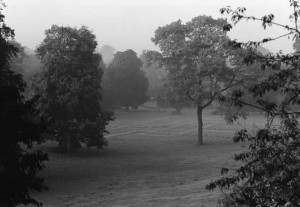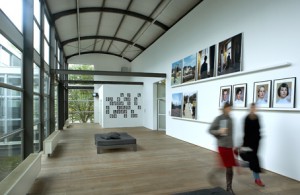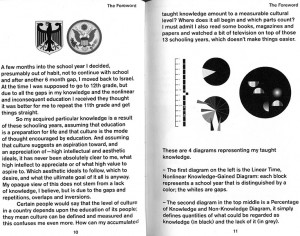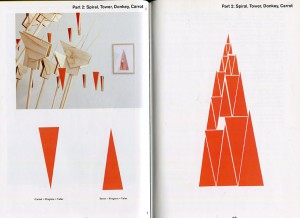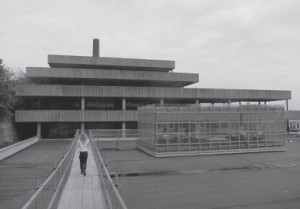A line, a letter, a page, a building, a photo, a book – separate stages that can either stand by themselves or remain transitioning points while executing somebody’s vision. It is common that an artist starts one’s creative process with making a sketch or writing down a sentence that popped out in the head, though, later on this idea might get a completely unexpected appearance. After the piece is created it will most likely be documented in a book, that sometimes serves as an autonomous work. Therefore, it is important to choose a right graphic designer to collaborate together for this process.
For my design research, I have decided to look into Alon Levin’s designed book ‘De Paviljoens: Journal of a Building 1992-2004’ that is a documentation of the former contemporary art pavilion in Almere.
According to the Artistic Managing Director of the Museum De Paviljoens, Macha Roesink, the aim of this book was to expose the complexity of building such as De Paviljoens and document the history in a case study of the life of a building, in the form of a journal composed of accounts by many of the people who have been involved.
Museum De Paviljoens
The building is transportable, like the ultimate kit, but it is standardized to meet building regulations. Documenting it in a book clearly makes it even more handy. I think it was not accidental that Alon Levin was invited to design the book as he himself works transiting from fine arts to design. To understand the concept of his way of working, it is important to look at his other projects.
In A. Levin’s book ‘Things Contemporary’ published by Dexter Sinister & Alon Levin, 2009 he talks about his interest in man’s eternal pursuit of order; not the ideal of order, which renders things absolute, resolve and static, but in the actual process of organizing things, which inevitably falls short. Artist takes up forms such as the triumphal arch, the victorious podium, or the Ferris wheel, and translates them into model-like wooden constructions and plaster forms reminiscent of the model. It creates images for the ambiguity of success and failure, for the instability of ideological, economic and scientific systems. Analogous to the accumulation and formation of knowledge in the “free encyclopedia” Wikipedia also Levin prefers, when he reused, deconstructed or repeated individual elements of his own works. Data, buildings and documents appear as moving building blocks in a constantly transforming and updating view of the world. To process this information, he uses charts, diagrams and transforms his knowledge into abstract geometrical shapes that later become sculptures or installations. Space-grabbing constructions from simple materials available in the construction market are based on the exploration of the technical and architectural achievements of the Western world and their significance for contemporary society.
Things Contemporary published by Dexter Sinister & Alon Levin, 2009
Even though, it seems Alon Levin himself does not see switching from graphic design to fine arts as transitioning, I was curious to find out when and how do these two spheres meet. His pieces and texts are based on invoke either the incalculably large or the immeasurably small, hence the mathematical sublime, the way in which they thematise structure and collapse points. Using the design made for ‘De Paviljoens: Journal of a Building 1992-2004’ and photos of various installations I tried to create some ‘systems’ that could represent their ‘shape’. I discovered he used three sizes for the font, therefore a zigzag in my drawings representing ‘text’ in the book is in three different sizes. Considering purified and structured shapes he applies into his pieces I decided to replicate both pages and 3D objects into slightly modified, geometricized shapes. At some point I realized a certain rhythm appears, which blurs the line between two subjects of my research.
Left – sketches of installations by Alon Levin, Right – schemes based on ‘De Paviljoens: Journal of a Building 1992-2004’
In fact, these two ‘sequences’ I made are just my interpretations of Levin’s creations. They might transit into something new and exciting at some point and that would probably be sort of an example the way the original author was building them. In ‘Things Contemporary’ he admitted that during his studies at Gerrit Rietveld Academie he wanted to understand the power of manipulating information: not just consume it, but to actually make it. To try and understand how all the information we ingest daily is organized and what the thoughts and structures behind it are. I think one of the best representations of this attitude is in his project ‘The Basics of Growth’ that dealt with similar ideas in botany as in economy, making some comparison through books that A. Levin had published himself. The content of these books was from Wiki that provides the material for the content of a book. He later on transits from the book into 3D structure based on the same subject, which in this case was a greenhouse on the rooftop of the office building.
The Basics of Growth
I presume researching the history of the pavilions, he applied this same method in a reverse version – firstly, understanding the building with its context and then transmitting it into a book.
Throughout my research I learned that the endless cyclical game is the fundament of Levin’s work – a natural flow that drives him from one medium to another.
De Paviljoens : journal of a building, 1992-2004 /Rietveld library catalogue no : 700.4 pav 1
